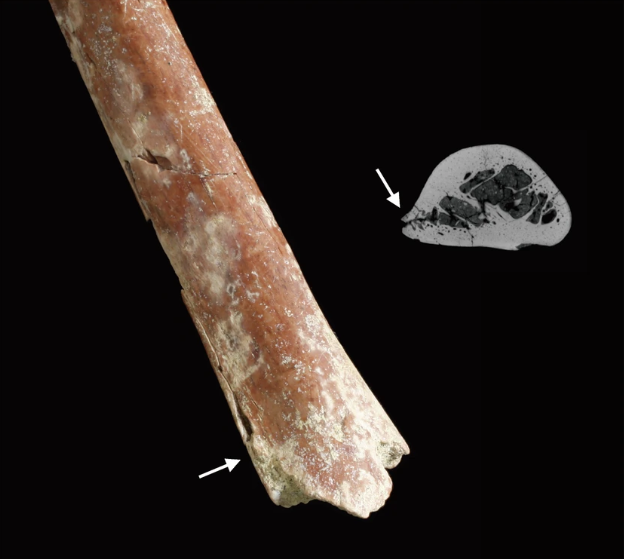Ancient 'hobbits' were even smaller than previously thought, scientists say
Scientists studying ancient cousins of humans have big news: A hobbit-like species was even smaller than previously thought.
Fossils of Homo floresiensis (dubbed "hobbits" for their resemblance to the fictional Middle-earth dwellers in the "Lord of the Rings" books) were first discovered in 2003. Those fossils showed they lived between 50,000 and 100,000 years ago on the Indonesian island of Flores, east of Bali. Flores is about the size of Puerto Rico.
Now, even older fossils from 700,000 years ago show that an early human species was likely about two-and-a-half inches smaller than their later ancestors. Both are believed to have evolved from an older, taller species called homo erectus.
The archaic humans, a now-extinct cousin to modern humans, were about slightly shorter than the average human four-year-old. The later hobbits were believed to be about 3 feet 6 inches tall. The older fossils show their predecessors could have been as short as about 3 feet 3 inches.

"With this discovery, we found they were even smaller than we thought, so it was quite shocking to me," said Yousuke Kaifu, a professor of anthropology at the University of Tokyo and first author of the paper, published Tuesday in the journal Nature Communications.
The original research, from a team of Indonesian and Australian archeologists, was first published in 2004 and stunned the world. It was led by renowned Australian archeologist Michael John Morwood.
Those first fossils were found in Liang Bua cave. The much older fossils Kaifu and others have studied came from another site on the island, called Mata Menge and help confirm research first published in 2016 showing the older hobbits were potentially even shorter than the later ones.
This week's paper is based on fragments of an upper arm bone and teeth from the same areas of Mata Menge, which Kaifu's Japanese-Australian team has been studying carefully ever since.
"It took a long time to have data that was convincing," he said.
'Strange evolution' created hobbits
Kaifu and others believe this particular species of human evolved from Homo erectus, another extinct human species that lived about two million years ago. Homo erectus means upright human because they walked upright.
"We know Homo erectus was on the island of Java 1.1 million years ago. Somehow they crossed the ocean and reached these islands and became isolated – and then they experienced a strange evolution," Kaifu said.
Sometime between 1.1 million years ago and 600,000 years ago, the Homo erectus people on the island of Flores evolved into hobbits. Then they maintained their small body size and survived for at least 500,000 years.
The nearest island is about six miles away across treacherous seas, so how they got there isn't known.
As to where they went, no one knows. They seem to have vanished from the island around 50,000 years ago. That might, or might not, have been around the time modern-day humans first arrived.
One thing that isn't mysterious: Why the early cousins of humans shrunk as they inhabited the island of Flores.

It's well-documented that animals on islands lacking predators can very quickly evolve much smaller forms, a process called phyletic dwarfism. It's been known to happen with deer, cattle, elephants, hippopotami and other species. It can also happen quickly.
In one example that started in 1871, feral cattle on Amsterdam Island in the southern Indian Ocean shrank to about three-quarters of their original body size in slightly more than a century.
In the case of the hobbits, Kaifu believes they quickly evolved to be smaller because there was nothing on the island that would have specifically hunted them.
"Without predators, there's no advantage to being large because you don't have to fight anything off," he said. "To maintain a larger body size you have to eat a lot, it takes more time to grow and produce offspring. So smaller body size is more productive."
While the hobbits didn't face predators, they still had to deal with the island's Komodo dragons and giant stork-like birds that stood almost six feet tall. "These were a big stress for them – they must have been intelligent," Kaifu said.
Small-brained as they were, the hobbits used stone tools and appear to have hunted some of the other dwarf animals on the island, including a mini elephant species called dwarf stegodons about the size of modern buffalo. the hobbits may also have used fire.
The hobbits aren't the only now-extinct tiny cousins to humans. In 2019 archeologists announced the discovery of another diminutive human species whose fossils were found in Callao Cave on the island of Luzon in the Philippines. Called Homo luzonensis, the species lived on the island between 50,000 and 76,000 years ago.
Disclaimer: The copyright of this article belongs to the original author. Reposting this article is solely for the purpose of information dissemination and does not constitute any investment advice. If there is any infringement, please contact us immediately. We will make corrections or deletions as necessary. Thank you.






